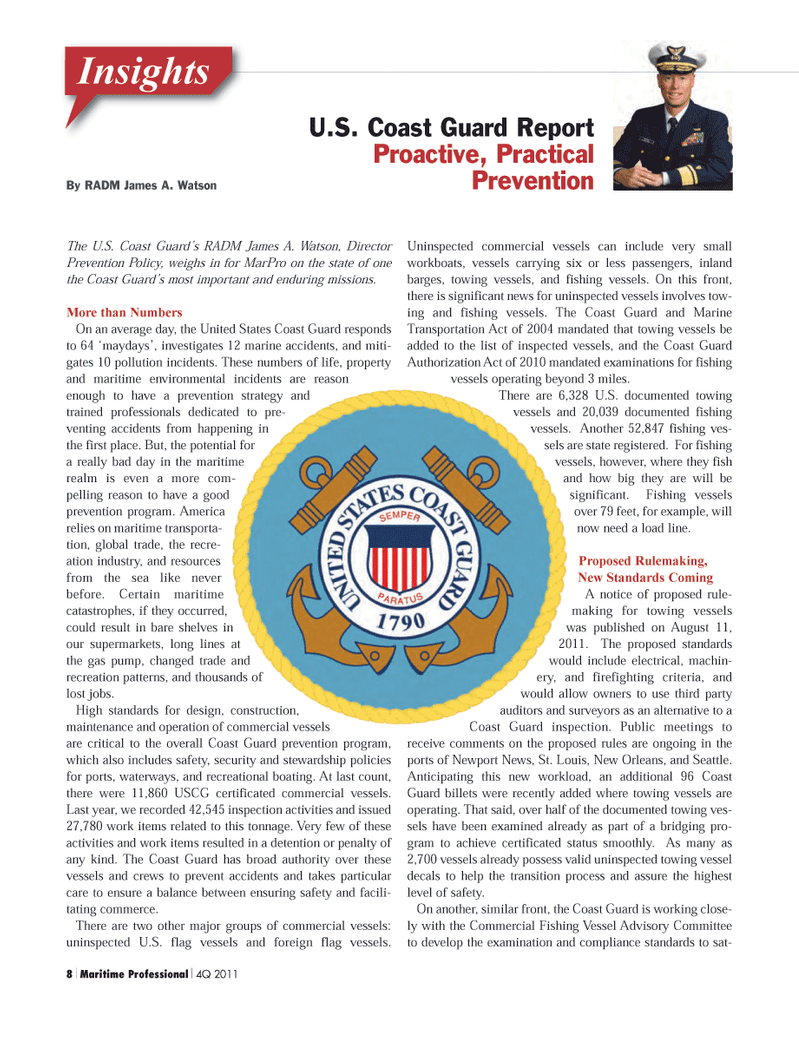
Page 8: of Maritime Logistics Professional Magazine (Q4 2011)
Classification
Read this page in Pdf, Flash or Html5 edition of Q4 2011 Maritime Logistics Professional Magazine
8 Maritime Professional 4Q 2011The U.S. Coast Guard?s RADM James A. Watson, Director Prevention Policy, weighs in for MarPro on the state of one the Coast Guard?s most important and enduring missions. More than Numbers On an average day, the United States Coast Guard responds to 64 ?maydays?, investigates 12 marine accidents, and miti- gates 10 pollution incidents. These numbers of life, property and maritime environmental incidents are reason enough to have a prevention strategy and trained professionals dedicated to pre-venting accidents from happening in the first place. But, the potential for a really bad day in the maritimerealm is even a more com- pelling reason to have a good prevention program. America relies on maritime transporta-tion, global trade, the recre-ation industry, and resources from the sea like never before. Certain maritimecatastrophes, if they occurred, could result in bare shelves in our supermarkets, long lines at the gas pump, changed trade andrecreation patterns, and thousands oflost jobs.High standards for design, construction,maintenance and operation of commercial vessels are critical to the overall Coast Guard prevention program, which also includes safety, security and stewardship policies for ports, waterways, and recreational boating. At last count, there were 11,860 USCG certificated commercial vessels. Last year, we recorded 42,545 inspection activities and issued 27,780 work items related to this tonnage. Very few of these activities and work items resulted in a detention or penalty of any kind. The Coast Guard has broad authority over these vessels and crews to prevent accidents and takes particular care to ensure a balance between ensuring safety and facili- tating commerce.There are two other major groups of commercial vessels: uninspected U.S. flag vessels and foreign flag vessels. Uninspected commercial vessels can include very small workboats, vessels carrying six or less passengers, inland barges, towing vessels, and fishing vessels. On this front, there is significant news for uninspected vessels involves tow- ing and fishing vessels. The Coast Guard and Marine Transportation Act of 2004 mandated that towing vessels be added to the list of inspected vessels, and the Coast Guard Authorization Act of 2010 mandated examinations for fishing vessels operating beyond 3 miles. There are 6,328 U.S. documented towing vessels and 20,039 documented fishing vessels. Another 52,847 fishing ves- sels are state registered. For fishing vessels, however, where they fish and how big they are will be significant. Fishing vessels over 79 feet, for example, will now need a load line. Proposed Rulemaking, New Standards ComingA notice of proposed rule-making for towing vessels was published on August 11, 2011. The proposed standards would include electrical, machin- ery, and firefighting criteria, and would allow owners to use third party auditors and surveyors as an alternative to a Coast Guard inspection. Public meetings toreceive comments on the proposed rules are ongoing in the ports of Newport News, St. Louis, New Orleans, and Seattle. Anticipating this new workload, an additional 96 Coast Guard billets were recently added where towing vessels are operating. That said, over half of the documented towing ves- sels have been examined already as part of a bridging pro- gram to achieve certificated status smoothly. As many as 2,700 vessels already possess valid uninspected towing vessel decals to help the transition process and assure the highestlevel of safety. On another, similar front, the Coast Guard is working close- ly with the Commercial Fishing Vessel Advisory Committee to develop the examination and compliance standards to sat- InsightsU.S. Coast Guard Report Proactive, Practical PreventionBy RADM James A. Watson MP #4 (1-17):MP Layouts 11/7/2011 4:21 PM Page 8

 7
7

 9
9
